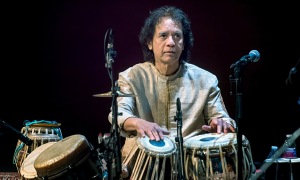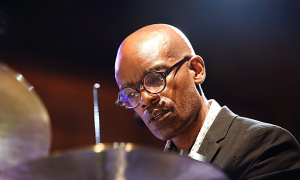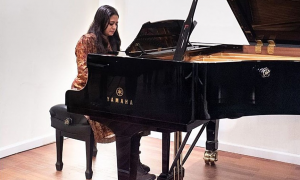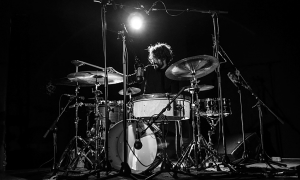Home » Jazz Articles » Under the Radar » The Word from Johannesburg, Part II: Brenda Sisane and T...
The Word from Johannesburg, Part II: Brenda Sisane and The Art of Sunday

If we say that ‘Without those slaves on ‘American soil’, it’s hard to imagine what would have happened musically.’ Then we should also say, without the migrations of slavery it is hard to imagine what actually would have happened across the globe, musically.
—Brenda Sisane
All About Jazz: How would you describe the current state of jazz in South Africa?
Brenda Sisane: The jazz scene in South Africa is enjoying an extraordinary revival, I would guess similar to the rest of the world if one were to look at what is happening in the UK, the US itself, even as far as Eastern Europe.
As a product of the country's political history, the jazz scene here is filled with amazing contradictions because the influences of local African traditions is underplayed in the mostly Western institutions that teach about jazz history thus omitting the reason for a nuanced organic persona that is distinct and unmistakably South African. For this reason, jazz in South Africa cannot be described in a cursory fashion. Considering that some of the most iconic South African jazz music was created in exile on other continents by South African artists who could not practice their craft at home, to avoid arrest and being accused as being political instigators, we still have the work of integrating the information for a common understanding.
Those who were left behind found expression during periods of unrest and constricting conditions that permeated the artistic spaces during apartheid. All these instances have enriched the jazz narrative and character of South Africa. Twenty-six years later after the first democratic elections, the scene has grown even more daring, fresh, and full of promise regardless of the usual funding challenges. No adequate investment is going into developing relevant infrastructures such as venues, memory building, and educational tools. The industry itself has to make things happen.
It is wonderful though to see a new breed of jazz musicians who have taken to the world stages due to their affinity with technology and the access they have generated, that has enabled them to tune into Bandcamp or similar spaces where they can upload their music and share/sell to broader audiences. Global aid funding seems to be on the rise again, encouraging collaborating with their peers from Europe for instance, and today we see a lot of bursaries provided for young musicians to study in the US, etc. All of these activities are validating the talents and emboldening the young musicians. There is also a resonant element of self-discovery by these young artists who are tech-savvy, some comfortable to choose jazz music as a field of study and a career; creating a definite upswing of creativity and an increased footprint for these aspiring musicians.
Another scene-setting is the high demand for the reissuing of exiled works, which represent a much-needed inter-generational connection. Artists such as Ndikho Xaba, Johnny Dyani, Pinise Saul are legends that we have previously not heard about, never seen or engaged with.
This exiled music gap between the youth and the elders and the exiled community needs help to recreate connections and perspective. My purpose with my work in the media is to make this possible.
We have recent scholars who are studying the history and bringing it to the fore. Previously this scholarly work was mostly done by those who had access to the information and means of documenting this history. Just before the dawn of democracy, some significant books emerged that carry weight in documenting South African jazz. A new direction is emerging, that considers more deeply, the role of indigenous knowledge systems in music, as a component of the jazz being produced in South Africa.
When it comes to the audience, we have always had a highly appreciative and organized jazz appreciation movement in South Africa. It is also growing well across the age spectrum, with an increasing number of vinyl and rare album collectors added to it, there is an upsurge of producers and vinyl spinning DJs and curators working with venues outside of the typical jazz club scene. A lifestyle of listening and socializing within this realm is taking shape in townships, restaurants and of late the digital concerts and shows are increasing.
Going back to appreciation clubs, they are the mainstay of the jazz scene. They buy tickets to concerts, festivals and buy CDs and albums in numbers. This unique culture of jazz societies emanates from social clubs in the townships, who save together to afford building their music collections. A few years ago, they formed a national coalition of hundreds of such formations mostly from the informal sector that was previously considered to be un-bankable due to their social standing (apartheid policies).
There is also an emerging movement to reissue works of jazz musicians some of whom died in exile, some whose estates are unresolved, and some whose rights need clearing and their work returned to their families. There is a huge demand for these works not only by South African jazz lovers but also educators, archivists, and researchers from across the borders are seeking to learn more about these hidden treasures of South African jazz. It has been asserted by opinion leaders and scholars that there are five distinct destinations of jazz in the world viz. The North, South America, Europe, Japan, and South Africa, the latter being considered as the most established jazz scene on the African continent. The Southern African block, for instance, has seen South African traditions such as Kwela, and Mbacanga influence Zimbabwe, Botswana, and Mozambique. Today the sound of the Mbira is strong is Zimbabwe.
I'm a little reluctant to speak about the advent of live streaming that has seen a significant growth as media owners and corporations realize that jazz has a growing audience base and today there are more jazz programs than ever before.
In fact, even talk radio stations have also seen value in tapping into this audience because jazz is highly topical today as a platform for social messaging and a call to action for social justice. However, South Africa is still way behind in creating an equitable access to data for people in rural communities to afford the streaming platforms. Quiet a contradiction since most of the authentic music traditions are still strong in rural communities. Mulatu Astatke the giant of Ethio Jazz and Ray Lema from The Democratic Republic of Congo will attest to this truth that if we want to learn about the music heritage of Africa, we have to visit the communities still living in the rural lands where indigenous traditions are still being passed on. In short, the jazz scene in South Africa is growing steadily and with the right nurturing could be a formidable economic activity.
AAJ: Explain the differences between mainstream U.S. jazz and South African jazz, and how the music incorporates indigenous elements.
BS: To quote Mandisi Dyantis, a gifted jazz trumpet player, singer, composer and arranger, who references Prof Hotel Galeta: "jazz arrived in South Africa via the touring naval ships through Cape Town bringing with them music much closer in nature to the local people that lived there." This article here below sheds a light in this regard.
In support of this I am also of the opinion that regardless of the stringent apartheid restrictions, South African jazz palates evolved to really embrace and appreciate jazz music as introduced by American visitors to our shores. This inspired the musicians to develop naturally their own brand of jazz with a distinct local indigenous influence. But that did not erase the American jazz sound and style. The South African jazz follower is very well informed about American jazz (and jazz from across the world like Europe, Cuba, Japan, Brazil and so on). The easily available content makes it even more so for both the musician and the appreciator. While this influence and reference cannot be doubted, South African jazz has its own nuance due to its indigenous influences just like Brazil and Cuba whose nuance has been accepted and highly considered; the traditions are unique to this part of the world, but to a very cultured taste, these traditions can be found in other parts of the continent.
AAJ: Is highlife music thought to be synonymous with jazz or just jazz-flavored?
BS: As with South Africa, jazz landed on fertile ground of improvised styles. This is as affirmed by Victor Dey, a jazz pianist from Ghana with whom I've enjoyed various discussions on this matter. The highlife of music of old (the best kind in my opinion) had quite a few jazz elements: the walking bass lines, some of the harmonies, the structure, the brass sections etc. So, to answer your question, I would say, it's more than a tinge, although I'm not so sure I'd go as far as saying it's synonymous with jazz. More like influenced by.
AAJ: KAYA-FM radio and The Art of Sunday feature programming that crosses borders within Africa and can be streamed globally. Can you talk about the implications of an international audience for South African jazz music?
BS: Indeed, my programme positioning is set that way, to create resonance with the sounds across borders to thusly share similarities and variances in the jazz dialects of the continent. Looking from the outside as journalists, it is always from the genesis of jazz founded on American ground. The lean in for me is on how this jazz was recognized by African forms of music which are inherently improvised often. I'm prone to telling the story from an African perspective to give this context; since Africans were amongst the slaves who were on "American soil" during its creation, and contributed to its creation. In telling this story I also incorporate that of American Masters then and now who continue to find the same resonance on African soil.
AAJ: Would you explain the distinguishing characteristics that differentiate jazz in South Africa from that of Central African or Western African countries?
BS: There is a noticeable shift...an argument raised by contemporary historians that in understanding the distinguishing characteristics of African jazz, we should look at pre-colonial times. This is where we will understand that the traditions found on these various territories existed before slavery and colonial times. The traditions have been passed down aurally and by demonstration for centuries.
Victor Dey says about the West African region and Central Africa that our music is very collaborative and is sometimes improvised. "Our music culture hit a roadblock when had coup d'états and curfews were imposed by the military governments. This meant that music and musicians had to take a backseat and a lot of musicians left the country and took their gifts with them."
Central and West Africa have their own distinct styles that evolved the Kora and local instruments for instance the Congo Kingdom of Kwasa Kwasa style, Ghana and Nigeria have Juju and Highlife popularized by Fela Kuti while Cameroon will have the soulful jazz style mixed with Makossa as made famous by Manu Dibango.
For West Africa, which are predominantly French colonies and in addition to that, the Muslim religion is highly influential in their music. We can add Mali the styles by the likes of Youssour Ndour and Salif Keita where the slave routes define the jazz sound they share.
Jazz in West Africa is a result of slave trade with the US and is strong by virtue of the fact that West Africa is much closer to Europe and America more than the southern block. The traditional styles in West Africa are strong and to borrow your words yes, tinged with jazz.
South Africa is more developed because of infrastructure, technology like the movie houses, radio, broadcasting and ICT that has helped this development. Therefore, in Southern Africa jazz is a sole type of music, and an industry on its own. In South Africa in particular, jazz is more institutionalized.
Moreira Chonguisa from Mozambique will gladly share the influences in his home country which is on the Southern bloc as well with Namibia, Zimbabwe and so on. Mozambique where Marabenta is the traditional urban sound from the south, emerged in Maputo during their civil war...it is a dance style found in rhumba, salsa, and most of the jazz musicians use Marabenta in their sound. You also have the rhythm called Chopi sound aka Timbila (a world heritage instruments six side rhythm) or Marimba and Mapiko from the North prevalent in the Southern block of Moz including some parts of SA. Tufo from Nampula biggest province in Mozambique with boasts a matriarchal system and is known for its harmonies and melodies evolved through slavery and are now typical to Moz.
I have enclosed a link to an article from which I quote:
Around 1530, the Spaniards began to import Negro slaves directly from Africa. The Portuguese did the same for their colony, Brazil. The Spaniards did not transport slaves themselves. The management of the profitable slave trade was taken over from the Portuguese by the French and then by the British. It is estimated that around ten million black Africans were moved from Africa in the cruel slave trade until the abolition of slavery around 1870. So, was it not the cultures of western and central Africa —and not the Spanish-Arabic culture —that came to dominate the development of Afro-American culture? We cannot say for certain. Islamic and Arabic cultures have had far greater significance in Africa than most people imagine. The slaves taken from West Africa came from countries with distinct Arabic cultural patterns. The falling thirds, characteristic of both West African singing and of the blues, should be related to the Arabic song tradition. The countries in the savannah belt are Islamic and show clear influences from Arabic culture. The countries along the Slave Coast are directly bounded by this Islamic savannah belt. The Swahili culture, stretching far down to eastern Africa south of the equator, also shows significant Arabic influences. The culture in Africa generally considered to have had the greatest impact on the beginning and development of Afro-American culture is that of the Yoruba people. They live in western Nigeria and in Benin. Nigerian author Ben Okri writes in his book, A Way of Being Free, that the Yoruba culture has its roots in the Middle East.' (Lindgren, Gunnar. The Arabic Roots of Jazz and Blues. Africa at Göteborg University. -2001.)
AAJ: What are your thoughts about the future of jazz, on the African continent?
BS: If we say that "Without those slaves on 'American soil,' it's hard to imagine what would have happened musically." Then we should also say without the migrations of slavery it is hard to imagine what actually would have happened across the globe, musically.
What I would love to see is more robust and eventful engagement on the role Africa played in contributing to world cultures from way before the arrival of slave ships. For this history to reflect accurate information not distorted in a way that it makes African music secondary to other musics, and to jazz. I would love to see how we can continue to weave these narratives for a bigger world of understanding humanity through music.
This is one way of elevating the narrative towards a more equitable status for Africans. In correcting the often-distorted heritage of Africa, its intellect and achievements, and in restoring the glory of African culture and its artifacts that have given other nations the reverence of being artistic hubs, we can help affirm Africans to themselves and to the world.
< Previous
The New Orleans Collection: Love Is T...
Next >
Like the Sun
Comments
Tags
For the Love of Jazz
 All About Jazz has been a pillar of jazz since 1995, championing it as an art form and, more importantly, supporting the musicians who create it. Our enduring commitment has made "AAJ" one of the most culturally important websites of its kind, read by hundreds of thousands of fans, musicians and industry figures every month.
All About Jazz has been a pillar of jazz since 1995, championing it as an art form and, more importantly, supporting the musicians who create it. Our enduring commitment has made "AAJ" one of the most culturally important websites of its kind, read by hundreds of thousands of fans, musicians and industry figures every month.






















